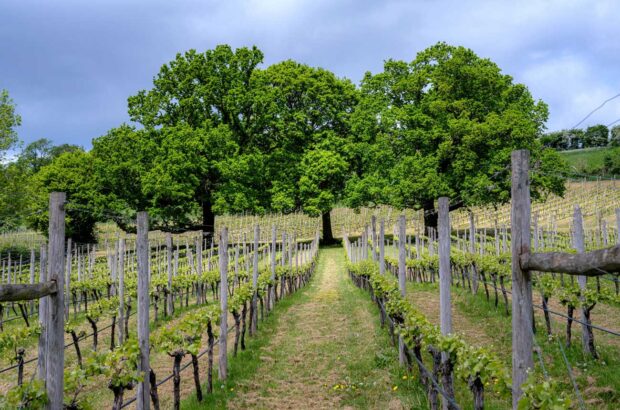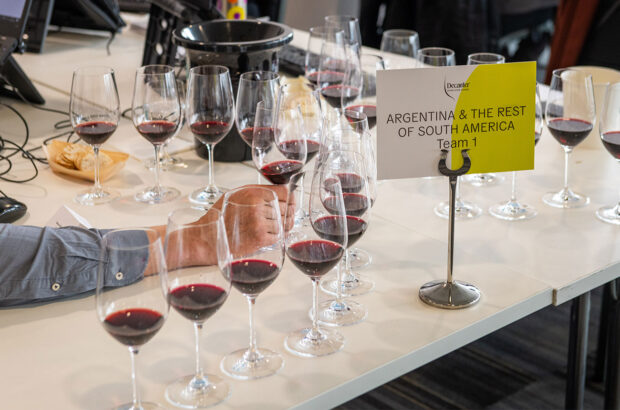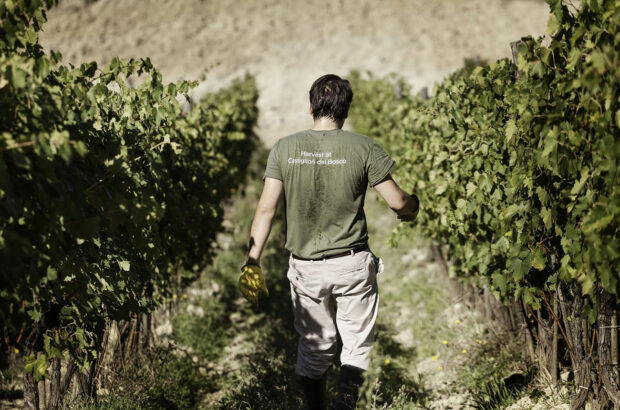This humble, former Anglo-Saxon kingdom, was included alongside the likes of South Carolina’s Low Country and Coastal Georgia (USA), the Terai in Nepal, and Chiriqui in Panama. Coming in at number eight, the publication stated ‘comprising the counties of Suffolk, Norfolk, Essex and Cambridgeshire [East Anglia] has been celebrated for offering a true taste of old England, combined with beautiful nature reserves […] lively coastal beach towns and picturesque inland waterways.’
In March of the same year, wineries from across East Anglia gathered in London at Spencer House, for the first time together, to showcase their wares to the wider wine trade and press. As a winemaking region still somewhat ‘under the radar’ with many of the vineyards here being planted as recently as 2017, the tasting gathered a serious crowd which attended with a genuine intrigue and thirst for discovery.
A true ‘taste’ of ‘old’ England, but could this region become a worthy ‘new’ face of English still and sparkling wine? Here are six unexpected vineyards worth a visit.
Tuffon Hall Vineyard, North Essex
This charming, off the beaten track vineyard and cellar door has been monikered ‘England’s greatest tasting room’ by Ed Dallimore in his book ‘The Vineyards of Britain’. Foremost an arable farm, in 2011, the 4th generation Crowther family diversified into wine, turning 12 acres of their 12,000 acre estate into vineyards after spending time in New Zealand and taking inspiration from the cellar door culture. Angus and his father enrolled at Plumpton and then began planting – first Bacchus, Pinot Meunier and Chardonnay, focused on making premium quality sparkling, then Pinot Noir in 2017, moving into still wines. A new Cabernet Noir vineyard was planted in 2023. Most of the wines are named after the family’s young children – Amelie (Bacchus), Beatrice (Pinot Noir Rosé) and Charlotte (a Pinot Noir/Pinot Meunier, Blanc de Noirs sparkling Rosé). A more recent addition and highlight is the glacial, limited edition 2023 Pinot Gris.
Supper clubs and weddings hosted in the 16th Century flint-clad Threshing Barn keep the place moving over the summer months, as well as three of the most charming rural shepherds huts – the Grain Silo belonging to Angus’s grandmother, complete with wood-fired hot tubs, and local produce including sausages and jacket potatoes, available on pre-order.

Image credit: Tuffon Hall Vineyard
Flint Vineyard, South Norfolk
Now Norfolk’s biggest beacon of sparkling wine, made uniquely in the Charmat style, Flint Vineyard has gained quite a fizzy following even if they didn’t intend to start out this way. Founded under the premise of making the best quality still wines, Ben Witchell traded a life in IT for one making wine, thanks too to a New Zealand visit followed by Plumpton. The Charmat foray came around after he was offered a parcel of fruit ‘he couldn’t refuse’, and since then the winery has installed its very own Charmat specific kit.
This year it launches a still single-vineyard Chardonnay, made from grapes from Martin’s Lane Vineyard in Essex’s Crouch Valley. The wine is dedicated to Roy Martin, a founding partner of this vineyard who passed away in June 2023, recognised for his significant contribution to the growth of Essex as a premium wine producing county. Other still wines still include the very fine Fumé Blanc (a textural 40% barrel fermented and oak aged Bacchus), Silex (a waxy, fresh blend of Chardonnay, Pinot Blanc, Pinot Gris and Pinot Noir) and Pinot Noir Précoce – a nod in style perhaps to Ben’s experience in Beaujolais, such is its silky, drinkable style.
A granite egg spied in the winery nods to a constant test and learn approach, and alongside ambitious new planting starting soon, as well as plans to host weddings, Friday & Sunday street food events, as well as their new daily Small Plates and Wine Bar it looks like no stopping for this passionate Norfolk team.
Chet Valley, East Norfolk
Rustic and rural in essence, this working winery and vineyard, 20 minutes by car from Flint, hosts visitors from April onwards each year, overlooking vines from its barn-like HQ into the bright Norfolk sun. ‘I see [Norfolk] as a frontier of winemaking. The upsides are the higher temperatures, the downside is the instability of the climate. With more sunshine also comes heavier showers,’ says owner-winemaker and chemist, John Hemmant. Chet is keenly intent on sustainability, working in partnership with Norfolk Wildlife Trust. One third of their total acreage is re-wilded and it was through hosting a PHD student from East Anglia University who charted birds (and insects) through their vineyards, that they came up with the names of their wines: Skylark, Red Kite, Swift, Chaffinch, Robin Redbreast, Siskin and Horatio.
Growing Chardonnay, Pinot Noir and Pinot Meunier as well as Piwi varieties (Piwi is short for the German term ‘Pilzwiderstandsfähige Reben’, meaning ‘fungus-resistant vines’) like Solaris, Schönburger and Cabernet Noir, their 10 labels are grown on sandy loam and boulder clay (clay with chalk chips). The ‘Skylark Brut’ is a 65% Phoenix 35% Seyval Blanc blend – Phoenix (a cross of Bacchus and a French hybrid) being ‘the prodigy of Bacchus’ so says John; aromatic, resistant, very reliable and ‘grows under the radar’. Seyval adds acidity, making it taste and feel ‘something between a Prosecco and a Champagne’. It is currently the largest traditional method producer in East Anglia, according to the owner.
Chet Valley Vineyard welcomes visitors from April to October (Monday to Saturday) in its purpose-built tasting room, complete with a balcony overlooking the vines. A series of foodie and fizz nights are planned for this summer – full details are available on the website.
Burn Valley, North Norfolk
‘If you head straight north, eventually you’ll reach the North Pole,’ so says our tour guide, former wine-merchant David Sleight from Burn Valley Vineyard as we’re touring the vines in the winery’s liveried working vehicle. Vineyards here, hidden a fifteen minute walk away from the winery, are gently sloping south facing, with the sea a mere six miles away.
Burn Valley makes two sparklings, a series of ‘Piwi’ whites including two different expressions of Solaris – one black label (fermented and aged in Hungarian oak for eight months), one white (fermented and aged in stainless steel with seven months of lees aging – giving their Chardonnay a nudge in terms of quality and expression). It is perhaps their reds however, that put them on the podium. Aged in Hungarian oak for 12 months, the Chalk Bed Reserve (Rondo and Regent blend) is one of the better, more robust reds I’ve tasted from England – backed up by their slew of WineGB awards in 2024. Earlier this month they were awarded Wine of the Year for their 2024 Marsh rosé in the Wine GB East Anglia Awards, as well as best white and red wine (for the Chardonnay and Pinot Noir respectively). They also make a Solaris late harvest, now in its second release, influenced by a previous cellar hand whose mother makes Tokaji in Hungary.
With summer events scheduled in conjunction with their catering arm, they are open every day except Tuesdays from 11am-3pm. From here you are also in shooting distance of North Norfolk Wine Cellars who pour the sparkling by the glass, and Nest Farmhouse, who serve up other wines and brews from nearby.
Burnt House Vineyard, Little Finborough, Suffolk
Formerly ‘just’ an arable farm, Burnt House was a standout vineyard at the Spencer House tasting for their wines that come well presented in smart new packaging this year, each made in a clean, approachable style – keeping the offering simplified, but not simple.
Vines here were first planted in 2017 with their first own vintage being 2021. The farm originally started supplying grapes to Ridgeview in Sussex, but now make their own labels; a neat selection of Burnt House Brut (current vintage is 2021), a Bacchus, Pinot Noir red, pretty Pinot Meunier rosé and a quite quaffable Chablis-esque Chardonnay. Burnt House have also just planted Pinot Gris, calling this variety out as a definite one to watch when in this neck of the woods.
The estate’s produce can be tasted at the Cellar Door, overlooking vines with a lone but striking oak tree in the middle that marks the halfway point. A sophisticated stop where you can also enjoy a wine-paired small plate menu alongside cheese and charcuterie. Open Friday to Sunday. See website for events and more details.

Gutters & Stars. Image credit: Sophie Mclean
Gutters & Stars, Cambridge
While not a vineyard, Gutters&Stars, founded by Chris Wilson, is certainly still worth a look. More progressive in style, as is the background and philosophy of this Plumpton trained winemaker, Wilson, alongside writing about wine and music, makes his own renditions in a charming old 1847 Windmill, in the middle of Cambridge.
In an area once surrounded by fields, grapes turn to alcohol in a variety of styles and methods. Second use barrels, a concrete egg and the classic stainless steel all feature in this snug home that has pumped out 21,000 bottles since first starting production in 2020. He prides himself on his Chardonnay – the wine he makes the most of, saying he loves to see ‘the kind of Chardonnay we can make in England if we take our time and don’t release things too soon’. This year’s releases include ‘Corridor of Uncertainty’ 2024 Ortega, Punka – a MVB rosé blend of Sauvignon Blanc, Ortega, Bacchus and a tiny bit of Pinot Noir.
Joining the lineup is a single barrel of 2023 Pinot Noir – ‘Dark End of the Street’ named after an old soul song – such is Wilson’s way, made with grapes from long-time partner grower, Missing Gate in Essex (who also make their own labels, the winemaking is done by Defined). A nod to an Italian, Alto Adige, style, he says. Chris is part of ‘The Plumpton class of 2013’ – a groovy group of winemakers comprising Sergio Verrillo (Blackbook), Alex Rabagliati (Rathfinny), Micaela English (Hidden Spring), Ben Witchell (Flint), Liam Idzikowski (Danbury Ridge) and Jeremy Mount (Woodchester Valley). Now to get the band back together.







